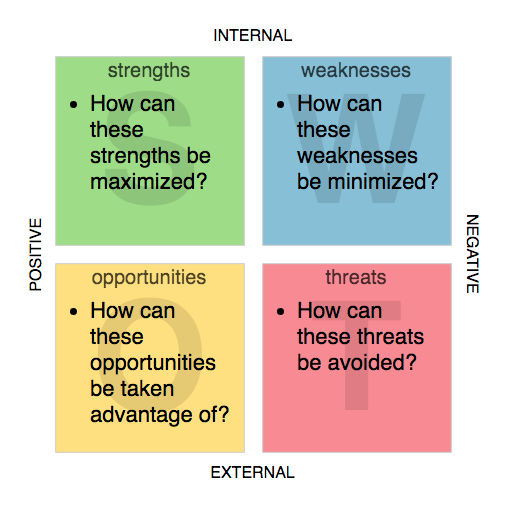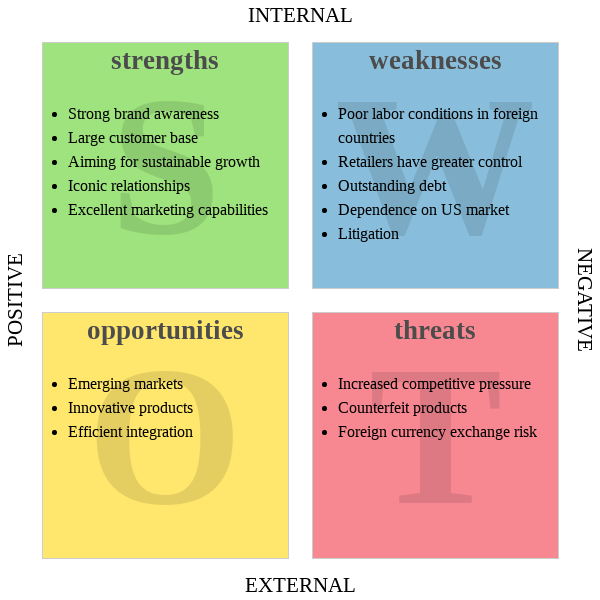Apa itu Analisis SWOT?
SWOT terdiri dari empat aspek, dimulai dengan huruf pertama dari kata: ” Kekuatan”, “Kelemahan”, “Peluang” dan “Ancaman”, secara singkat, ini adalah penilaian situasi kompetitif yang mengidentifikasi strategi respons yang tepat melalui analisis lingkungan industri internal dan eksternal. Ini sering digunakan untuk analisis pasar, promosi produk baru, strategi komunikasi pemasaran, dan pelaksanaan rencana operasional, dan dapat digunakan sebagai referensi untuk pelaksanaan strategi guna meningkatkan efisiensi rencana ini.
SWOT terkait dengan wawasan merek kita sendiri dan tren industri, dan wawasan ini mungkin menggunakan beberapa alat analisis data, tetapi pada dasarnya tidak perlu memiliki tingkat alat analisis dalam diskusi SWOT.
Ini diusulkan oleh Heinz Weihrich, seorang profesor di Universitas San Francisco, dalam sebuah makalah pada tahun 1982, ketika SWOT ditransformasikan dan diterapkan, dan berbagai matriks digabungkan dan dicantumkan untuk menghasilkan berbagai proposal strategi.
Bagaimana cara menggambar Matriks SWOT?
Saat melakukan diskusi SWOT, perlu bagi semua peserta untuk menyampaikan “pernyataan objektif” dan agar semua orang memiliki pemahaman yang sama tentang tujuan merek untuk mencapai hasil yang lebih efektif.
- Kekuatan dan kelemahan terkait dengan produk dan layanan merek itu sendiri, berfokus pada “internal” faktor.
- Peluang dan ancaman terkait dengan perubahan dalam segmen pelanggan kunci akibat lingkungan, berfokus pada “eksternal” faktor industri.

- Kekuatan: Karakteristik dari suatu bisnis atau proyek yang memberikannya keuntungan relatif terhadap bisnis atau proyek lainnya.
- Kelemahan: Karakteristik yang menempatkan perusahaan atau proyek pada posisi yang kurang menguntungkan dibandingkan dengan perusahaan atau proyek lainnya.
- Peluang: faktor-faktor di lingkungan eksternal yang dapat digunakan perusahaan atau proyek untuk keuntungannya.
- Ancaman: Faktor-faktor di lingkungan eksternal yang dapat menyebabkan masalah bagi perusahaan atau proyek.
Contoh SWOT: NIKE
Anda dapat menemukan masalah internal NIKE dan pengaruh eksternal, tetapi Anda juga dapat mengetahui kekuatan pengembangan internal dan peluang pasar eksternal. Di antara mereka, Anda dapat menemukan bahwa beberapa strategi operasional NIKE mudah digunakan. Anda dapat mempelajari satu atau dua hal dari diagram contoh SWOT di bawah ini:

Edit template Analisis SWOT ini
KEUNGGULAN INTERNAL NIKE
- Konsumen memiliki pengenalan merek yang kuat
- Mengakumulasi basis pelanggan yang besar
- Bertujuan untuk pengembangan yang berkelanjutan
- Hubungan ikonik (seperti kemitraan Air Jordan)
- Kemampuan pemasaran tim yang sangat baik
Kelemahan Internal NIKE
- Kondisi tenaga kerja yang buruk di luar negeri
- Pengecer memiliki banyak kontrol (hampir 70% dari saham)
- Utang menimbulkan ancaman finansial
- Ketergantungan pada pasar AS
- Gugatan internal perusahaan
Peluang Eksternal untuk NIKE
- Ekspansi Pasar Berkembang
- Pengembangan produk inovatif
- integrasi yang efisien
Ancaman Eksternal bagi NIKE
- tekanan kompetitif yang meningkat
- Produk palsu berlimpah
- risiko fluktuasi mata uang
This post is also available in Deutsch, English, Español, فارسی, Français, 日本語, Polski, Portuguese, Ру́сский, Việt Nam, 简体中文 and 繁體中文.













